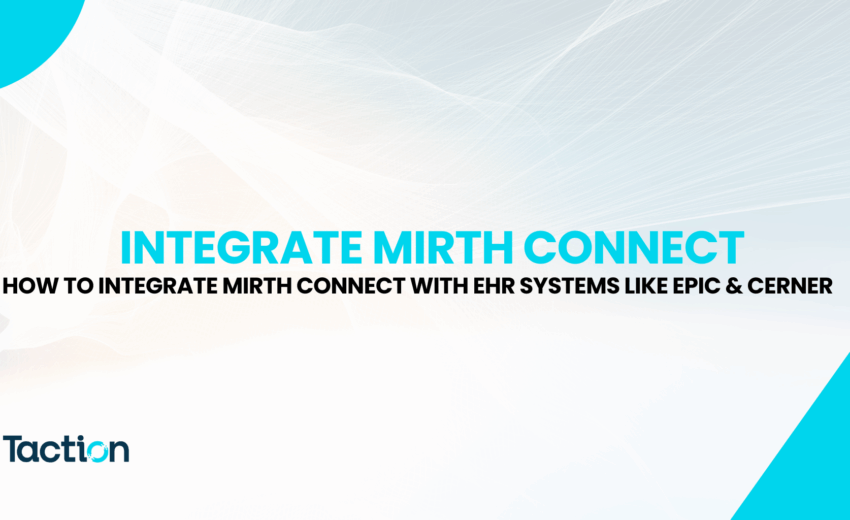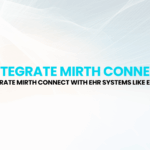
The future of healthcare depends on how well systems communicate. Hospitals and clinics rely on multiple Electronic Health Record (EHR) systems, yet achieving seamless communication between them often feels like navigating a maze. Epic and Cerner — two of the most widely adopted EHR platforms — manage vast amounts of patient data, but integrating them with other applications and systems remains a challenge.
That’s wher Mirth Connect comes in. Known for its flexibility, scalability, and compliance with healthcare standards, Mirth Connect enables organizations to create secure, efficient bridges between their EHRs and external systems. When implemented strategically Mirth EHR integration can transform fragmented data flows into an interconnected ecosystem — powering better care coordination and real-time decision-making.
💡 Why Healthcare Organizations Need EHR Integration
EHR systems are at the core of modern healthcare operations. From patient registration and diagnosis to billing and reporting, every step generates valuable data. However, when systems don’t communicate properly, this data becomes siloed — trapped in one system, invisible to another.
For example, a hospital might use Epic for inpatient data, Cerner for laboratory results, and a third-party telemedicine app for virtual visits. Without integration, physicians and administrators must switch between systems, manually re-enter data, or rely on outdated information.
Effective Mirth EHR integration eliminates these barriers. It connects multiple systems so that each piece of patient data — demographics, clinical history, lab results, imaging, prescriptions — flows smoothly between applications. The result? Streamlined workflows, fewer errors, faster reporting, and improved patient outcomes.
⚙️ Mirth Connect: The Core of Healthcare Interoperability
Mirth Connect is an open-source healthcare integration engine built specifically to handle complex data exchange between healthcare systems. It supports industry standards such as HL7 v2/v3, CDA, X12, DICOM, and FHIR — making it ideal for both legacy and next-generation systems.
🔧 Key Features of Mirth Connect
- Universal Connectivity: Integrates with EHRs, laboratory systems, billing software, medical devices, and health information exchanges.
- Data Transformation: Converts and maps data between formats — for example, transforming HL7 v2 messages into modern FHIR JSON or XML resources.
- Channel-Based Architecture: Enables modular, configurable workflows for each data source and destination.
- Compliance Ready: Built with HIPAA, GDPR, and other healthcare data privacy standards in mind.
- Scalable and Reliable: Handles high-volume data transactions across multiple facilities without downtime.
In short, Mirth Connect is the bridge between healthcare systems that speak different “languages.” It ensures data moves seamlessly, securely, and intelligently — whether your organization uses Epic, Cerner, or a combination of both.
🔗 Integrating Mirth Connect with Epic EHR
1. Understanding Epic Integration Framework
Epic supports multiple ways to integrate, including HL7 interfaces, APIs, and FHIR endpoints. The Epic FHIR Mirth approach uses RESTful APIs and standardized FHIR resources to access data securely and efficiently. This allows external systems — such as patient apps, analytics platforms, or other hospital databases — to retrieve and update Epic data in real time.
2. Configuring Mirth Connect for Epic
To integrate Mirth with Epic:
- Set up Mirth channels with HTTP connectors to communicate with Epic’s RESTful FHIR APIs.
- Authenticate using OAuth 2.0 for secure API access.
- Define mappings between Epic’s FHIR resources (like Patient, Observation, or Encounter) and your organization’s internal data structures.
- Apply transformation logic where needed — for example, converting HL7 lab results into FHIR Observations.
3. Benefits of Epic FHIR Mirth Integration
- Real-time data access across systems and devices.
- Reduced manual entry through automated message routing.
- Simplified data transformations between old and new systems.
- Enhanced patient engagement via API-driven mobile and web apps.
By leveraging Epic’s open FHIR ecosystem through Mirth Connect, healthcare organizations gain greater flexibility and control over how their data is shared and utilized.
🔗 Integrating Mirth Connect with Cerner EHR
1. Cerner Integration Framework
Cerner supports both HL7 and FHIR-based interfaces, making it compatible with Mirth Connect’s architecture. Through Cerner Mirth interface configurations, healthcare organizations can synchronize patient demographics, scheduling, test results, and billing data across multiple platforms.
2. Setting Up Mirth Channels for Cerner
- Configure source and destination connectors in Mirth to receive or send data to Cerner’s API endpoints.
- Use message filters to ensure only valid and authorized data flows between systems.
- Map HL7 or proprietary Cerner data structures into standard formats like FHIR for wider interoperability.
- Implement channel monitoring, alerting, and retry mechanisms for reliability.
3. Benefits of Cerner Mirth Interface Integration
- Enables real-time data exchange between Cerner and third-party systems.
- Improves workflow efficiency in laboratories, radiology, and billing departments.
- Enhances compliance with interoperability standards by using secure APIs.
- Reduces maintenance costs by centralizing data transformations within Mirth Connect.
The Cerner Mirth interface not only reduces integration complexity but also lays the foundation for advanced analytics, patient engagement, and telehealth initiatives.
🧩 Common Challenges and How to Overcome Them
1. Data Standardization
Epic and Cerner often use different versions of HL7 and FHIR, requiring precise data mapping. Mirth Connect’s transformer and scripting tools help align data elements between systems.
2. API Security
EHRs enforce strict authentication and authorization protocols. Use OAuth 2.0 tokens, SSL encryption, and access control policies to secure every data exchange.
3. Performance Optimization
High-volume message processing can slow down poorly designed channels. Proper channel architecture, message batching, and load balancing are essential for maintaining performance.
4. System Updates
Both Epic and Cerner release periodic updates that may impact integrations. Maintaining version-controlled Mirth configurations ensures continuity and prevents downtime.
5. Compliance
Every integration must comply with HIPAA and regional privacy laws. Implement message logging, audit trails, and secure transmission to maintain regulatory confidence.
🌍 Real-World Impact of Mirth EHR Integration
A well-designed Mirth integration architecture can transform how healthcare data is managed and exchanged. Organizations report:
- Faster Data Access: Clinicians retrieve complete patient information in seconds instead of minutes.
- Improved Accuracy: Automated data transformation reduces transcription errors.
- Higher Efficiency: Interfaces run 24/7 without manual intervention.
- Better Analytics: Unified data feeds enable real-time dashboards and AI-based insights.
- Lower Costs: One integration engine replaces multiple point-to-point interfaces.
The combination of Epic FHIR Mirth and Cerner Mirth interface integrations creates a unified digital health ecosystem capable of supporting telemedicine, population health, and predictive analytics.
🚀 Best Practices for a Successful Integration
- Start Small: Begin with one module — such as lab results or demographics — and expand gradually.
- Use Standard Profiles: Leverage official FHIR profiles (like US Core) to ensure interoperability consistency.
- Validate Thoroughly: Test message formats and mappings across all endpoints.
- Implement Monitoring: Set up Mirth Connect alerts for message failures or performance drops.
- Train Your Team: Equip administrators with Mirth channel management skills for sustainable operations.
- Plan for Growth: Design scalable architectures that can handle new endpoints or data sources in the future.
Following these steps ensures that your integration remains stable, compliant, and adaptable as your organization grows.
🧠 The Future of Healthcare Integration
The shift toward value-based care, AI-driven analytics, and patient-centered digital platforms is accelerating the need for robust interoperability. Both Epic and Cerner are expanding their FHIR capabilities, allowing external systems to exchange data in real time.
With Mirth Connect as your integration backbone, you’re not just solving today’s data challenges — you’re preparing for the future of healthcare interoperability. Whether it’s connecting IoT medical devices, powering mobile health apps, or enabling population-level analytics, the combination of Mirth EHR integration, Epic FHIR Mirth, and Cerner Mirth interface solutions ensures your organization stays ahead.
✅ Conclusion
Integrating Mirth Connect with Epic and Cerner bridges the gap between modern healthcare systems. It empowers organizations to exchange data securely, automate workflows, and deliver better patient care through real-time insights.
At Taction Software, our experts specialize in designing, implementing, and maintaining healthcare interfaces that align with your strategic goals. Whether you’re launching a new FHIR initiative, optimizing existing Mirth channels, or expanding across multiple EHRs, we provide end-to-end support for seamless, compliant, and future-ready interoperability.
📞 Talk to Our Integration Experts Today
Ready to simplify your Epic or Cerner data exchange?
Contact Taction Software for expert-led Mirth EHR integration and FHIR support tailored to your organization.





